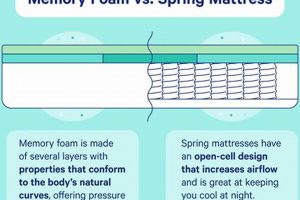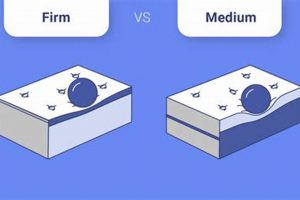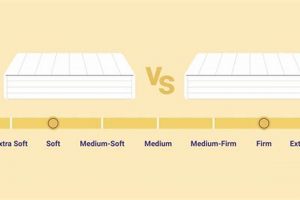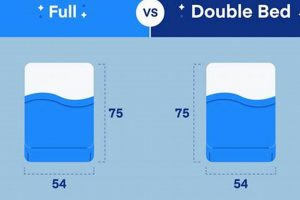The central question of selecting a suitable sleeping surface often revolves around two dominant types: innerspring and foam. Innerspring mattresses utilize a network of coils to provide support and bounce, while foam mattresses rely on various densities and compositions of foam, such as memory foam or latex, to contour to the body. Understanding the distinct characteristics of each is crucial for making an informed purchase.
Choosing the correct mattress significantly impacts sleep quality and overall well-being. A supportive mattress can alleviate pressure points, promote proper spinal alignment, and minimize sleep disturbances. Historically, innerspring mattresses were the standard. However, the introduction of foam mattresses offered alternative comfort profiles and addressed specific needs, such as motion isolation and pressure relief. This shift broadened consumer options and necessitated a more nuanced understanding of mattress characteristics.
Consequently, a detailed comparison of these mattress types is warranted. Subsequent sections will examine their construction, comfort characteristics, support mechanisms, durability, and suitability for different sleeping preferences and physical needs. This comprehensive analysis aims to equip individuals with the knowledge necessary to determine which mattress type best aligns with their specific requirements.
Guidance on Mattress Selection
Selecting the optimal mattress necessitates careful consideration of individual needs and preferences. The following points offer guidance in navigating the decision between innerspring and foam options.
Tip 1: Prioritize Support. Regardless of material, ensure adequate spinal support. A mattress that allows the spine to maintain its natural curvature is crucial for minimizing back pain and promoting healthy posture.
Tip 2: Assess Pressure Relief. Individuals experiencing joint pain or pressure point sensitivity should prioritize mattresses known for pressure relief. Memory foam, in particular, is often recommended for its contouring properties.
Tip 3: Consider Sleeping Position. Side sleepers often benefit from softer mattresses that conform to the body’s curves, while back and stomach sleepers may prefer firmer options to prevent spinal misalignment.
Tip 4: Evaluate Temperature Regulation. Some mattresses, particularly those made with traditional memory foam, can retain heat. If temperature sensitivity is a concern, explore options with cooling technologies or consider innerspring mattresses known for better airflow.
Tip 5: Account for Motion Isolation. If sharing a bed, consider motion isolation. Foam mattresses generally excel at minimizing motion transfer, reducing sleep disturbances caused by a partner’s movements.
Tip 6: Research Durability. Investigate the expected lifespan of different mattress types. Higher-quality materials and construction typically translate to greater longevity.
Tip 7: Test Before Purchase. When feasible, test mattresses in person to assess comfort and support levels. Lie in various sleeping positions to evaluate suitability.
Thorough assessment of these factors will facilitate a more informed selection, leading to enhanced sleep quality and overall well-being.
The subsequent segment will offer a concise summary of the key distinctions and considerations discussed, providing a foundation for a confident purchase decision.
1. Support
Support, in the context of mattress selection, refers to the capacity of the sleeping surface to maintain proper spinal alignment and distribute body weight evenly. This characteristic is paramount for mitigating back pain, promoting healthy posture, and ensuring restful sleep. The debate between innerspring and foam mattresses often hinges on which material provides superior support for individual needs.
- Coil System Integrity
Innerspring mattresses rely on the coil system to offer support. The type of coils (e.g., Bonnell, pocketed, continuous) and their gauge influence the overall firmness and responsiveness. For example, a mattress with individually wrapped pocketed coils can provide targeted support, minimizing motion transfer and conforming to the body’s contours. However, a poorly constructed coil system may sag prematurely, leading to inadequate support and potential discomfort.
- Foam Density and Composition
Foam mattresses derive support from the density and composition of the foam layers. High-density foams provide a firmer, more supportive base, preventing excessive sinking. The type of foam used (e.g., memory foam, latex, polyurethane) also influences the degree of support and responsiveness. For instance, a mattress with a high-density polyurethane foam core can offer stable support, while a softer memory foam layer conforms to the body for pressure relief.
- Edge Support Mechanisms
Edge support is a crucial aspect of overall support, particularly for individuals who sleep near the edge of the bed or require assistance when getting in and out. Innerspring mattresses often incorporate reinforced edge coils, while foam mattresses may feature high-density foam perimeters. Inadequate edge support can lead to sagging, reduced usable sleeping surface, and difficulty in performing tasks such as sitting on the edge of the bed.
- Zoning and Targeted Support
Some mattresses incorporate zoning, which involves varying the firmness of different sections of the mattress to provide targeted support to specific areas of the body, such as the lumbar region. Zoned innerspring mattresses may utilize coils of different gauges, while zoned foam mattresses may incorporate foams of varying densities. This approach aims to optimize spinal alignment and pressure relief based on individual body contours.
The selection between innerspring and foam mattresses for support depends on individual preferences and physiological requirements. Innerspring mattresses generally offer a firmer, more responsive feel, while foam mattresses provide a conforming, pressure-relieving experience. Considerations such as sleeping position, body weight, and sensitivity to pressure points should guide the choice, ensuring optimal spinal alignment and minimizing discomfort.
2. Conformity
Conformity, in the context of mattress selection, denotes the ability of the mattress surface to adapt to the contours of the human body. This characteristic is crucial for distributing pressure evenly, alleviating pressure points, and promoting healthy spinal alignment. The extent to which a mattress conforms directly impacts comfort, sleep quality, and the potential for pressure-related discomfort. The contrasting material properties of innerspring and foam mattresses lead to significant differences in their conforming capabilities.
Innerspring mattresses, due to their construction based on interconnected or individually pocketed coils, generally offer less conformity than foam mattresses. While the coils provide support, they often create localized pressure points, particularly around areas of the body with prominent curves, such as the hips and shoulders. This can lead to discomfort, tossing and turning, and disrupted sleep. Conversely, foam mattresses, particularly those incorporating memory foam or latex, possess superior conforming properties. These materials mold to the body’s shape, distributing weight more evenly and minimizing pressure points. For instance, a side sleeper might experience less pressure on their shoulder and hip when using a memory foam mattress compared to an innerspring mattress, due to the foam’s ability to cradle these areas. This enhanced conformity can translate to reduced pain and improved sleep quality.
The practical significance of understanding mattress conformity lies in its direct impact on individual comfort and well-being. Individuals with existing joint pain, pressure sensitivity, or spinal issues may benefit substantially from the conforming properties of foam mattresses. Furthermore, the ability of a mattress to conform can improve blood circulation and reduce muscle tension, contributing to a more restful and restorative sleep experience. While innerspring mattresses may offer advantages in terms of airflow and support for some individuals, the enhanced conforming capabilities of foam mattresses often provide a superior solution for those seeking pressure relief and improved sleep quality. The specific type and density of foam employed within the mattress construction further dictates the extent and quality of conformity experienced.
3. Durability
Durability, concerning mattress selection, refers to the lifespan and resistance to wear and tear exhibited by the product under normal usage conditions. It represents a crucial consideration when evaluating the “spring mattress vs foam mattress which is better” debate, as it directly impacts long-term value and overall cost-effectiveness. A durable mattress retains its support and comfort characteristics over an extended period, minimizing the need for frequent replacement. Innerspring and foam mattresses exhibit varying durability profiles due to their distinct construction and material composition. The degradation of mattress components, such as coil fatigue in innerspring models or foam compression in foam models, can lead to reduced support, sagging, and ultimately, the necessity for replacement. This directly illustrates the cause-and-effect relationship between inherent mattress durability and the consumer’s long-term satisfaction and cost savings.
The construction materials and manufacturing processes significantly influence mattress durability. Innerspring mattresses with high-gauge steel coils and reinforced edge support tend to exhibit greater longevity compared to those with lower-quality components. Similarly, foam mattresses made from high-density foams, such as latex or high-density memory foam, typically demonstrate superior resistance to compression and deformation. Real-life examples underscore this point. A memory foam mattress constructed with low-density polyurethane foam may develop body impressions and sag within a few years, while a latex mattress can maintain its shape and support for a decade or more. Proper mattress care, including the use of a mattress protector and regular rotation, can also extend the lifespan of both innerspring and foam mattresses.
Ultimately, understanding the durability characteristics of innerspring and foam mattresses is essential for making an informed purchasing decision. While initial cost may be a primary consideration, evaluating the long-term value proposition is crucial. A more durable mattress, even with a higher upfront cost, can prove more economical in the long run by minimizing replacement frequency. This consideration ties directly into the “spring mattress vs foam mattress which is better” conversation, highlighting the practical significance of evaluating long-term performance and cost-effectiveness rather than solely focusing on immediate price points. The challenges lie in objectively assessing durability claims and understanding the specific material compositions and construction techniques employed by different manufacturers.
4. Temperature
Temperature regulation is a crucial consideration when evaluating mattress types. Body temperature fluctuations during sleep significantly impact sleep quality, and the ability of a mattress to dissipate heat is paramount for maintaining a comfortable sleep environment. The material properties of innerspring and foam mattresses exhibit notable differences in their capacity to regulate temperature, thus influencing the “spring mattress vs foam mattress which is better” debate.
- Airflow Dynamics
Innerspring mattresses, by virtue of their internal coil structure, generally offer superior airflow compared to foam mattresses. The open spaces between the coils facilitate ventilation, allowing heat to dissipate more readily. Conversely, foam mattresses, particularly those constructed from dense memory foam, tend to restrict airflow, potentially leading to heat retention and discomfort. For example, an individual residing in a warmer climate may find an innerspring mattress more comfortable due to its enhanced breathability.
- Material Composition Influence
The specific materials used in mattress construction significantly influence temperature regulation. Certain types of foam, such as open-cell memory foam or latex foam, exhibit improved breathability compared to traditional closed-cell memory foam. Similarly, the presence of cooling technologies, such as gel infusions or phase change materials, can enhance the temperature-regulating properties of both innerspring and foam mattresses. An individual prone to night sweats might benefit from a mattress incorporating cooling gel technology to mitigate heat buildup.
- Humidity Impact
Humidity levels can exacerbate the temperature-related challenges associated with certain mattress types. High humidity can reduce the effectiveness of natural cooling mechanisms, such as perspiration, leading to increased discomfort on mattresses that retain heat. In such environments, innerspring mattresses with their superior airflow may offer a more comfortable sleep experience compared to foam mattresses, particularly those made with less breathable materials.
- Cover Fabric Contribution
The type of fabric used for the mattress cover also contributes to temperature regulation. Natural fibers, such as cotton or bamboo, tend to be more breathable than synthetic fabrics, promoting airflow and reducing heat retention. A mattress cover made from moisture-wicking fabric can further enhance temperature control by drawing perspiration away from the body. Consumers should consider the cover material when evaluating the overall temperature performance of a mattress.
The interplay of these factors ultimately determines the temperature performance of a mattress. While innerspring mattresses generally exhibit superior airflow, advancements in foam technology have led to the development of materials and construction techniques that mitigate heat retention. The ideal choice depends on individual preferences, climate conditions, and specific needs related to temperature sensitivity. Therefore, a comprehensive assessment of these considerations is essential for making an informed decision within the “spring mattress vs foam mattress which is better” framework.
5. Motion isolation
Motion isolation, the capacity of a mattress to minimize the transfer of movement across its surface, represents a significant factor in the evaluation of “spring mattress vs foam mattress which is better.” This characteristic directly impacts sleep quality, particularly for individuals sharing a bed. The extent to which a mattress isolates motion determines the degree to which one sleeper’s movements disturb the other. In this context, material composition and construction techniques dictate performance. The “spring mattress vs foam mattress which is better” question inherently involves assessing which type more effectively dampens movement, thus promoting uninterrupted sleep. For instance, a restless sleeper on one side of an innerspring mattress might cause significant disruption to their partner due to the interconnected nature of the coils, leading to noticeable movement transmission. However, a memory foam mattress, with its ability to absorb motion at the point of impact, often minimizes these disturbances. This directly influences comfort, sleep depth, and overall satisfaction with the mattress.
Foam mattresses generally excel in motion isolation due to their dense, interconnected cellular structure. Memory foam, in particular, conforms to the body and absorbs movement energy, preventing it from propagating across the surface. In contrast, innerspring mattresses, especially those with interconnected coil systems, tend to transfer motion more readily. While individually pocketed coils offer improved motion isolation compared to interconnected coils, they still do not match the performance of high-density foam. Real-world scenarios highlight this difference. Consider a couple where one partner frequently gets up during the night. A foam mattress would minimize the disruption caused by these movements, whereas an innerspring mattress might result in noticeable bouncing or shaking, potentially waking the other partner. Thus, understanding the principles of motion isolation becomes fundamentally crucial for optimizing the sleeping arrangement and maintaining undisturbed rest, especially in shared sleeping spaces.
In summary, motion isolation is a pivotal aspect of the “spring mattress vs foam mattress which is better” comparison. Foam mattresses, due to their material properties and construction, generally offer superior motion isolation capabilities compared to innerspring mattresses. While advancements in innerspring technology have improved motion isolation to some extent, foam remains the preferred choice for those prioritizing minimal sleep disturbance from a partner’s movements. The practical challenge lies in assessing motion isolation through testing or examining mattress specifications, considering that individual experiences and sensitivities may vary. The ultimate decision rests on the relative importance of motion isolation compared to other factors like support, temperature regulation, and budget considerations, all contributing to the optimal mattress selection for shared sleep environments.
6. Cost
Cost represents a primary determinant in the selection between spring and foam mattresses. This financial consideration interacts with other factors, such as durability and comfort, to influence the overall value proposition. A comprehensive assessment of the cost implications of each type is essential for informed decision-making.
- Initial Purchase Price
The upfront cost of innerspring and foam mattresses can vary significantly based on factors like materials, construction, and brand reputation. Generally, entry-level innerspring mattresses tend to be more affordable than entry-level foam mattresses. However, high-end models of either type can command similar or even greater price points. A direct comparison of specific models is necessary to accurately assess initial purchase costs.
- Material Composition and Pricing
The materials used in mattress construction directly impact the overall cost. Mattresses incorporating high-density memory foam, latex, or specialized coil systems typically carry a higher price tag. Innerspring mattresses utilizing premium materials, such as individually wrapped coils or high-quality ticking, will likewise reflect this in their price. A consumer should investigate the specific materials used and their corresponding cost implications.
- Long-Term Cost Considerations
While the initial purchase price is a primary concern, long-term cost considerations are equally important. The lifespan and durability of a mattress influence its overall cost-effectiveness. A more expensive mattress that lasts significantly longer may prove to be a better value than a cheaper option requiring more frequent replacement. Evaluating the expected lifespan and potential maintenance costs is essential for a comprehensive cost assessment.
- Warranty and Return Policies
Warranty and return policies can mitigate some of the financial risk associated with mattress purchases. A mattress with a longer warranty provides assurance against manufacturing defects and premature degradation. Similarly, a generous return policy allows consumers to test the mattress in their home environment and return it if it does not meet their expectations. These policies represent an indirect cost factor, as they can potentially save consumers money in the event of dissatisfaction or product failure.
In conclusion, the cost factor within the spring versus foam mattress debate is multi-faceted, involving the initial purchase price, material considerations, long-term durability, and the protective influence of warranty and return policies. A balanced evaluation of these elements, tailored to individual budget constraints and value priorities, is critical for achieving the optimal mattress selection.
Frequently Asked Questions
This section addresses common inquiries regarding the selection between innerspring and foam mattresses, providing objective information to aid in informed decision-making.
Question 1: Which mattress type is better for individuals with back pain?
The suitability of a mattress for back pain depends on individual spinal alignment needs and pressure point sensitivity. Both innerspring and foam mattresses can provide adequate support, but the specific characteristics vary. Innerspring mattresses offer firmer support, while foam mattresses, particularly those with memory foam, conform to the body, distributing weight more evenly and potentially reducing pressure on the spine. Consultation with a healthcare professional is recommended to determine the optimal mattress type for individual back pain conditions.
Question 2: Do foam mattresses sleep hotter than innerspring mattresses?
Traditional memory foam mattresses are known to retain heat due to their dense structure and limited airflow. However, advancements in foam technology have led to the development of more breathable foams, such as open-cell memory foam and gel-infused foam. Innerspring mattresses generally offer better airflow due to their internal coil structure, making them potentially cooler sleeping surfaces. Consideration of individual temperature sensitivity and the specific materials used in mattress construction is crucial.
Question 3: How does durability compare between spring and foam mattresses?
The durability of a mattress depends on the quality of materials and construction techniques. High-quality innerspring mattresses with robust coil systems and reinforced edge support can exhibit excellent longevity. Similarly, foam mattresses made from high-density foams, such as latex, tend to be more durable than those made from lower-density polyurethane foam. Regular mattress care, including rotation and the use of a mattress protector, can extend the lifespan of both types.
Question 4: Which mattress type is more suitable for couples with different sleeping habits?
Foam mattresses generally excel in motion isolation, minimizing the transfer of movement across the surface. This can be beneficial for couples with different sleeping habits or those who are easily disturbed by their partner’s movements. While some innerspring mattresses incorporate features to improve motion isolation, they typically do not match the performance of foam mattresses in this regard.
Question 5: What is the typical price range for spring and foam mattresses?
The price range for both innerspring and foam mattresses can vary considerably depending on the brand, materials, and construction. Entry-level innerspring mattresses tend to be more affordable than entry-level foam mattresses. However, high-end models of either type can command similar or even greater price points. Consumers should research specific models and compare prices to make an informed purchasing decision.
Question 6: How can one assess the quality of a mattress before purchasing?
Assessing the quality of a mattress involves examining several factors. These include the materials used, construction techniques, coil system (for innerspring mattresses), foam density (for foam mattresses), warranty, and return policy. Reading reviews from reputable sources and testing the mattress in person, if possible, can also provide valuable insights into its quality and suitability.
These FAQs address some of the most pertinent questions regarding the selection between innerspring and foam mattresses. However, individual needs and preferences should always be the primary drivers of the decision-making process.
The following section provides a concise summary of the key considerations discussed, facilitating a streamlined understanding of the core differences between innerspring and foam mattress options.
Conclusion
The comprehensive examination of “spring mattress vs foam mattress which is better” reveals a nuanced landscape, devoid of a universally superior option. Innerspring mattresses, characterized by their coil-based support systems, offer enhanced airflow and a firmer feel. Foam mattresses, leveraging the conforming properties of materials like memory foam and latex, excel in pressure relief and motion isolation. Durability, temperature regulation, and cost considerations further contribute to the decision-making process. Ultimately, the optimal choice hinges on a thorough assessment of individual sleeping preferences, physiological needs, and budgetary constraints.
Therefore, the selection between spring and foam mattresses necessitates a deliberate and informed approach. Careful consideration of the factors outlined herein empowers consumers to prioritize specific attributes, aligning their purchase with their unique requirements. The long-term impact of this decision on sleep quality and overall well-being underscores the importance of thoughtful evaluation and responsible acquisition.







![Leesa vs Casper Mattress: Which Bed is Best [2024]? Organic & Natural Mattress Buyer’s Guide: Non-Toxic Sleep Solutions Leesa vs Casper Mattress: Which Bed is Best [2024]? | Organic & Natural Mattress Buyer’s Guide: Non-Toxic Sleep Solutions](https://mattressworldpa.com/wp-content/uploads/2025/07/th-1078-300x200.jpg)